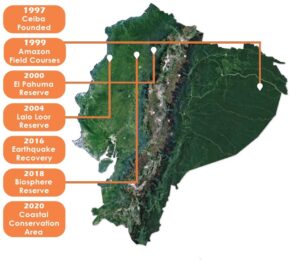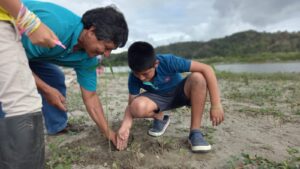
Ecuadorian mantled howler monkeys thrive in Lalo Loor Dry Forest Reserve

Ceiba has been working in Ecuador for the past 25 years to create a world where people and biodiversity thrive because of one another. Since our founding in 1997, we have been dedicated to forest protection, environmental education, and empowering local conservation leaders.
Q: What inspired the founding of Ceiba? Why did you choose to work in Ecuador?
Joe Meisel: I had interned for a nonprofit in Paraguay, where I learned that a small group of committed people can make a real difference. While visiting Catherine’s masters research sites in Amazonian Ecuador, the rainforest inspired us to protect tropical species and educate people about the importance of biodiversity.
Q: Twenty-five years of conservation work is no small feat! What is your fondest memory?
Catherine Woodward: I was thrilled when we signed the conservation easement in 2020 to protect the Lalo Loor Dry Forest. Handing over management to the landowner’s family was the culmination of a fifteen-year relationship to build trust, engage the community, and conserve this incredibly threatened ecosystem.
Q: How has Ceiba’s mission evolved?

Joe: We’ve always believed that people will protect nature if they see the benefits it provides. Ceiba has grown from working with a single family at El Pahuma (left: Joe Meisel and Catherine Woodward from El Pahuma’s 2002 inauguration), to a few communities near Lalo Loor, and today we’re collaborating with four counties on Ecuador’s coast to encourage region-wide conservation.
Climate change, biodiversity loss, and socioeconomic inequality are societal challenges pressing all of us to change, and to embrace the values of sustainability and social justice. Throughout Ceiba’s 25-year history, preparing for change has been at the heart of our conservation strategy. We have focused on protecting and restoring forests that absorb CO2. We have emphasized linking the remaining habitats along Ecuador’s coast. We’ve promoted land uses that help secure water, and buffer against droughts. While people recognize that nature-based solutions like reforestation can benefit both society and nature, few realize that combating climate change depends on conserving intact, biodiverse ecosystems. Where there is diversity, there is the capacity to adapt and thrive.
Ceiba’s conservation programs have always paired protection of habitat and economic livelihoods. We firmly believe the best managers of conservation projects are those who live and work in the areas being protected, and we are dedicated to promoting local leadership. The Lalo Loor Reserve, now managed by Mariela Loor, is flourishing under her capable guidance. In 2023 we will launch a grants program to support locally-run conservation initiatives; Seas and Forests Conservation Alliance, founded in Ecuador by Ceiba staff members, will be one of the first recipients. And here at home, our new Humboldt Diversity Scholarship awarded $18,000 to make our study abroad programs more accessible to students of color so we can continue training the next generation of leaders.
Our mission of connecting people and nature has helped both our organization and the communities with whom we work prepare for and adapt to change. We are grateful to our donors, and all our community partners, who join us as members of a global movement towards environmental sustainability and social justice. Al Futuro!
 Seas and Forests Conservation Alliance was born in 2022 from the dream of three friends (right: María José, Mariela, and Doménica) to generate a positive impact in the conservation of coastal, marine, and forest ecosystems and support sustainable livelihoods of local actors who live in these places. Our organization begins with a vision of gender equality and education, believing in women and education as a key element to achieve sustainable conservation practices. The worldview and ways of life of our communities are closely linked to nature, which is why we seek to promote and support sustainable socio-environmental activities. — María José Rendón
Seas and Forests Conservation Alliance was born in 2022 from the dream of three friends (right: María José, Mariela, and Doménica) to generate a positive impact in the conservation of coastal, marine, and forest ecosystems and support sustainable livelihoods of local actors who live in these places. Our organization begins with a vision of gender equality and education, believing in women and education as a key element to achieve sustainable conservation practices. The worldview and ways of life of our communities are closely linked to nature, which is why we seek to promote and support sustainable socio-environmental activities. — María José Rendón

Ceiba Foundation is a proud supporter of bio-entrepreneurship. We partner with AsoProCoffee, an association led by local women who produce some of the coast’s best coffee, while conserving forest and wildlife on their farms. How have they achieved this? They use an agroforestry system with high-quality coffee under the shade of fruit and timber trees which provide food and habitat for howler monkeys, hummingbirds, toucans, anteaters, and more (left: collared araçari, a small toucan found in forest and shade coffee). Such farms slow climate change by protecting big trees that store carbon. This bio-entrepreneurship project is an inspiring example of gender justice and a model for regional coffee owners to follow.
Field coordinator Marcos Cevallos working in the mangroves

To complement our conservation of dry forests, Ceiba is focusing on mangrove reforestation with support from local governments and Ecuadorian universities. Mangroves are among the most threatened ecosystems in the world, but play vital roles in providing resiliency to climate change, and valuable animal habitat (right: Green Iguanas rely on palms and mangroves for food and shelter). Because mangrove trees are resistant to salinity they are one of few plants that thrive along salty shores. Intricate root systems act as nurseries for marine life like shrimp and juvenile fishes, and protect shorelines from erosion by increasingly powerful winds and waves. Ceiba has focused our restoration efforts on the Briceño and Don Juan rivers in the coastal county of Jama. This year we planted over 200 mangrove trees along 800 meters of riverbank with the help of Heifer Foundation, local nonprofits, and county governments. One species, the piñuelo mangrove (Pelliciera rhizophorae, above) is highly threatened: only a few plants remain in the region. In partnership with the Eloy Alfaro University in Pedernales, our team trekked through the mud of the Mache estuary to collect seeds from the last surviving trees. Reforesting this and other mangrove species is key to saving native biodiversity and reviving Ecuador’s coastlines.

In the new Conservation and Sustainable Use Area (ACUS), Ceiba’s team is protecting forests and rivers, and promoting sustainable land uses, to prepare Ecuador’s coast for climate change. With support from the US Fish & Wildlife Service, Ceiba helps landowners implement “farm plans” that identify conservation actions, with emphasis on streamside forests that protect water and connect habitat. Field coordinator Marcos Cevallos works with landowners to map areas for fencing, agriculture, reforestation, and conservation. This year, five farm plans include drinking troughs for cattle and 10,000 feet of fencing to keep cows out of clearwater streams, decrease erosion, and revitalize streambanks. Marcos led restoration of six miles of riparian forest and mangroves, with nearly 2,000 trees planted. But finding native tree seedlings is a challenge! That’s why Ceiba gave seed money (hah!) to boost capacity at seven local plant nurseries that nurture native species and deliver essential trees as demand for reforestation grows.
Restoration must be paired with defense of existing forests, so Ceiba’s program leader Doménica Gutierrez is enrolling properties in the Forest Partners (Socio Bosque) incentive program: 976 acres are slated for protection, financed by carbon credits. Ceiba is even advising county and national governments on legal incentives like conservation easements, laying a foundation for biodiversity protection across Ecuador.
The Ecuadorian White-fronted Capuchin (banner image, Cebus aequatorialis) was named a critically endangered species by the IUCN Red List in 2015. Deforestation is the primary threat, forcing highly mobile capuchins to relocate into areas inhabited by humans, and causing conflicts as they forage in croplands. The coastal forests of Ecuador were singled out by the IUCN as ideal habitat and a priority area for conservation action. Capuchins live in habitats ranging from wet Andean forests to dry lowland forests, and a troop has been found living in the Lalo Loor Reserve! Ceiba’s ACUS project is creating habitat corridors to protect migration routes and increase suitable habitat for endangered capuchins, howler monkeys, and many other species.

When I was a University of Wisconsin student wavering about my career path, I was lucky enough to take Dr. Woodward’s Tropical Rainforests and Coral Reefs course, and later Ceiba’s Tropical Conservation Semester. Priceless experiences, cross-cultural exchanges, and quality education gave me first-hand experience in conservation, immediately influencing my career trajectory. Now and for the past three years, I also have been the teaching assistant for Ceiba’s Marine Biology program in Belize, and I look forward to co-leading the course this summer (right: author Teal Guetschow, at home in Belize). I can remember sitting in an oceanside room on Ecuador’s coast, learning about fishing practices and conservation. Now, you can find me earning my Ph.D. in that exact space — the nexus of fisheries management and species conservation in Trinidad and Mexico. From an undergraduate to a doctoral student, Ceiba provided me with invaluable hands-on experiences that allowed me to grow into the conservation practitioner I am today.
Want to keep up to date with Ceiba’s projects? Sign up for our quarterly newsletter!
We promise that we will never sell your contact information to anyone else.